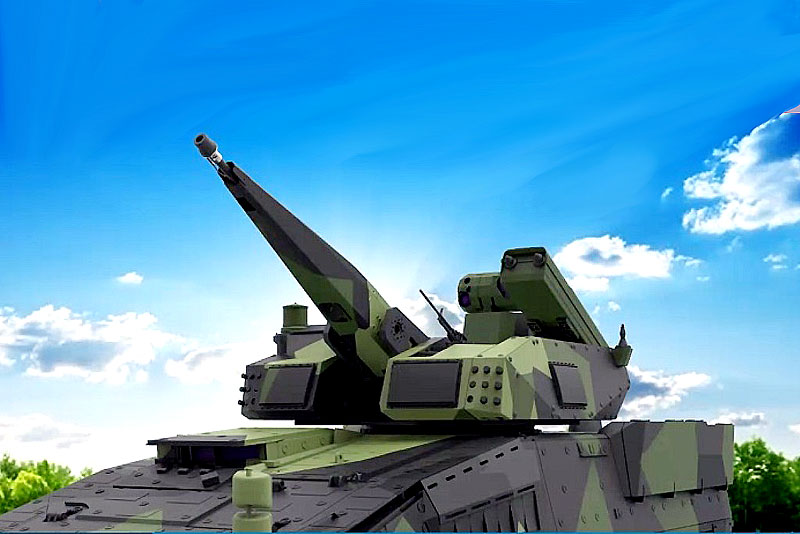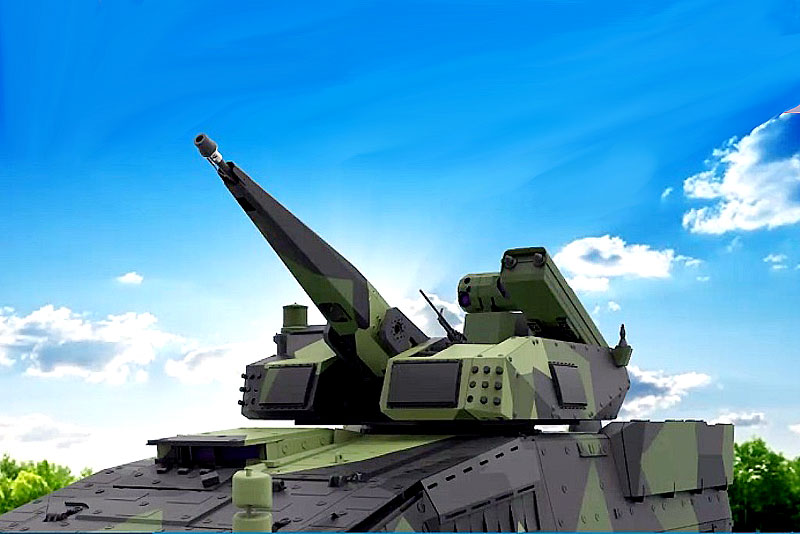
(to be upgraded soon with further information and pictures)
By Paolo Valpolini
“The Nagorno Karabakh conflict has shown a series of gaps in air defence assets,” Fabian Ochsner, Rheinmetall Air Defence (RAD) CEO told the audience at the Digital Defence Talks session organised online by the Düsseldorf-based group. Mr. Ochsner also pointed out that most western land forces got rid of their mobile air defence assets at the end of the Cold War. Germany i.e. put out of service its Gepards twin-35 mm AD tracked systems (which turret weighed over 11 tonnes); however recently a German MoD study revealed that the Bundeswehr would have had problems to counter the air threats that appeared in the aforementioned conflict. Speaking from Oerlikon, near Zurich, Switzerland, where the air defence branch of Rheinmetall is based, he introduced a new product, currently at concept demonstrator stage, that will be refined in the near future, taking into consideration potential customers comments, before making it a real product. Named Skyranger 30, it follows the path of the Skyranger 35, the mobile ground based air defence system built around the 35 mm Oerlikon Revolver Gun, which was shown for the first time over 16 years ago.
A much lighter solution, 2-2.5 tonnes versus 4-4.5 tonnes, the new remotely controlled turret can be fitted onto the bigger 6×6 wheeled armoured vehicles, and obviously on 8×8 wheeled as well as on tracked vehicles considerably extending the number of potential platforms. The idea is to provide army units with a mobile system capable to engage fixed wing, rotary wing, Group I and II unmanned air systems, and cruise missiles, exploiting the combination of a medium calibre gun system using airburst munitions and SHORAD missiles, the limited weight of the cradle, 250 kg, of the gun, and of the overall turret allowing the integration of such missiles within the desired weight limit.
Speaking in front of the concept demonstrator Dr. Moritz Vischer, Product Manager for Effectors at RAD, went through the system peculiarities, highlighting that the company did its best to generate a well balanced system in terms of sensors and effectors, leveraging the R&D work and the deep knowledge that it has in both those fields, giving birth to an “agile, aware and effective system”. He started from the first link of the air defence chain, that is sensors allowing target detection; “The first issue is to see the target, which is not easy task when dealing with small items such as Class I UAVs. The detection sensor adopted on the Skyranger 30 is an S-band AESA multi-mission radar, five flat antennas being integrated around the turret to provide full 360° coverage,” he explained, adding that the new radar was tested in Switzerland one day prior the presentation, starting its qualification process. The S-band provides a detection range of around 20 km, the system being optimised for small targets in order to cope with most recent threats. An active system is always a target for RF-seeking weapons, hence RAD installed on its Skyranger 30 a passive detection system, in the form of Rheinmetall’s FIRST (Fast InfraRed Search and Track) that allows surveillance without giving out the presence of the Skyranger. “This sensor is also optimised to detect pop-up targets, as the typical helicopter threat has not gone away,” Dr. Vischer points out.
The second link of the chain, once detection has been made, is identification and tracking. Here too Rheinmetall developed a sensor head that includes one thermal imager, one TV channel and two laser rangefinders; this was tested in 2020 against a set of classic and new types of targets proving to be a balanced solution, according to company officials. Rheinmetall has also in its portfolio an X-band radar that would perfectly fit the new Skyranger, should a customer require an active tracking system.
At this point it is time to engage the threat. “We resurrected the old Oerlikon KCA 30×173 mm cannon used on board the Saab 37 Viggen fighter aircraft,” Vischer said, explaining that starting from a very powerful and already existing weapon, and inserting new technologies, allowed to reach the desired result in a very short time. The new cannon, named KCE, is able to shoot 16 rounds per second, the Skyranger 30 carries 250 ready rounds on one side of the gun, and is fitted with a single muzzle coil allowing programming airburst munitions (until now a three-coil system was used on 35 mm cannons), a further weight saving measure. Another key feature of the Skyranger 30 is the elevation, which can reach 85°, allowing engaging threats during their terminal dive. One key element in increasing the kill probability is the ABM round; leveraging the experience acquired with the 35 mm AHEAD ammunition the new 30 mm ABM round carries a total of around 160 tungsten cylinders for a total payload of around 200 grams. The concept is the same of the AHEAD: once the fire control system has established the intercept point, the ABM round leaves the muzzle being time-programmed to open up at the optimal distance in front of the target generating a lethal cone of high-strength metallic cylinders. Dr. Vischer showed a UAV hit by such rounds, one cylinder having gone through the optronic sensor, continuing its travel penetrating the battery and putting the system on fire, something discovered only after recovering the target which was treated with three 30 mm rounds, “but one would have been sufficient,” the PM Effectors noticed. The 30 mm ABM round has already obtained the NATO qualification and is already in service.
Compared to the 35 mm, which according to RAD has a maximum effective range of around 4.5 km, the 30 mm reaches 3 km, with pretty similar terminal effects. Thanks to the reduced weight of the gun system and sensors the Skyranger is also able to integrate missile systems that allow it to considerably extend its reach. “We are missile agnostic,” says Fabian Ochsner, underlining that currently talks are underway for adding a laser beam riding missile, however fire-and-forget IR missiles can also be integrated, not forgetting the work being done with Halcon, the EDGE company from the UAE, which is providing its SkyKnight missile to be integrated into RAD’s Skynex. “Such missiles can extend the effective range up to 8-9 km, however they have a minimum engagement range of around 2 km, which is exactly where the cannon is the most effective,” Dr. Vischer explains, therefore the Skyranger 30 allows covering seamlessly all the envelope from very close ranges up to the maximum ones.
To be effective a system must first of all remain alive. “The first rule is not to be seen, thus we developed a very low profile turret, which does not give away the vehicle,” the PM Effectors says, showing in real that the concept demonstrator has also been fitted with two Rheinmetall’s ROSY (Rapid Obscuring System) launchers fitted to the turret, each with nine multispectral smoke rounds. A machine gun can be fitted on the left of the main gun, to be used as self-defence weapon. The Skyranger 30 features a central armoured structure, which at distance is fitted with add-on armour, basic protection being at Level 2, which can be increased upon request of the customer to Level 4 according to STANAG 4569, which obviously has an impact on weight. A hatch in the hull ceiling allows the vehicle commander to have a direct view of the battlefield. Protected at Level 4, it can also be used as an escape hatch in case of emergency.
Further adds-on are being considered, such as i.e. electronic warfare systems, in the form of passive emitter locators, able to pick-up data link signals used by UAVs, as well as RF-jammers, to jam such data link, neutralising UAVs without even engaging the main gun.
According to Fabian Ochsner the Skyranger 30 is currently at TRL 4-5, “but we are planning first firing trials around the middle of the current year,” Dr. Vischer announces, also unveiling that a first contract for the KCE gun has been bagged for a naval application. Rheinmetall Air Defence thus aims reaching TRL 6 for its Skyranger 30 by year end, when all subsystems will have been tested, adding that the system will then remain at that stage until a launch customer will show up.

Rheinmetall Air Defence unveils its Skyranger 30 (upgraded) - EDR Magazine
By Paolo Valpolini “The Nagorno Karabakh conflict has shown a series of gaps in air defence assets,” Fabian Ochsner, Rheinmetall



